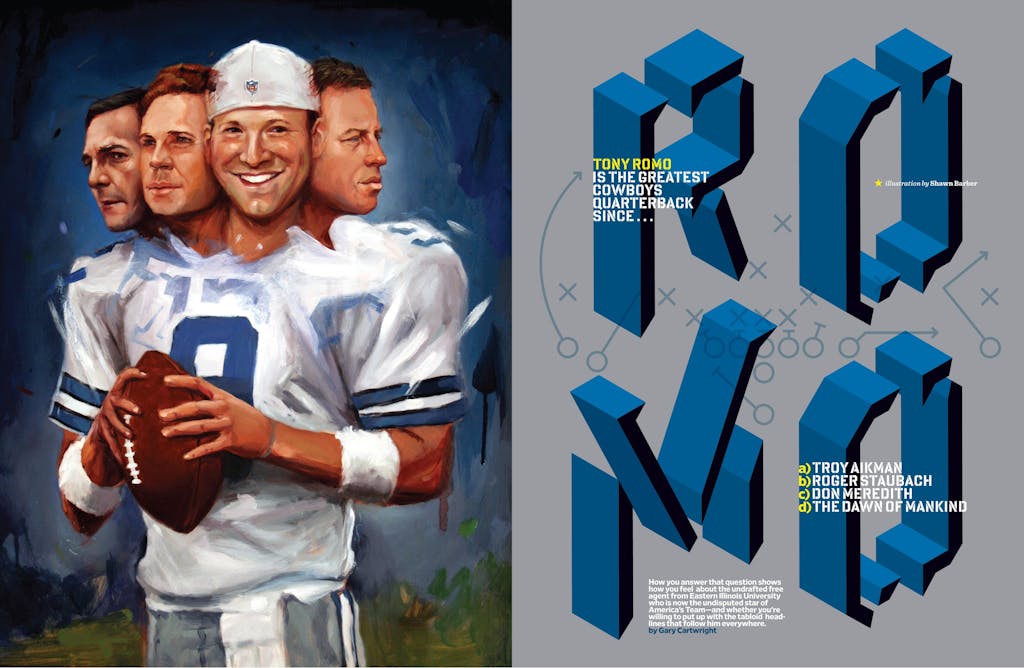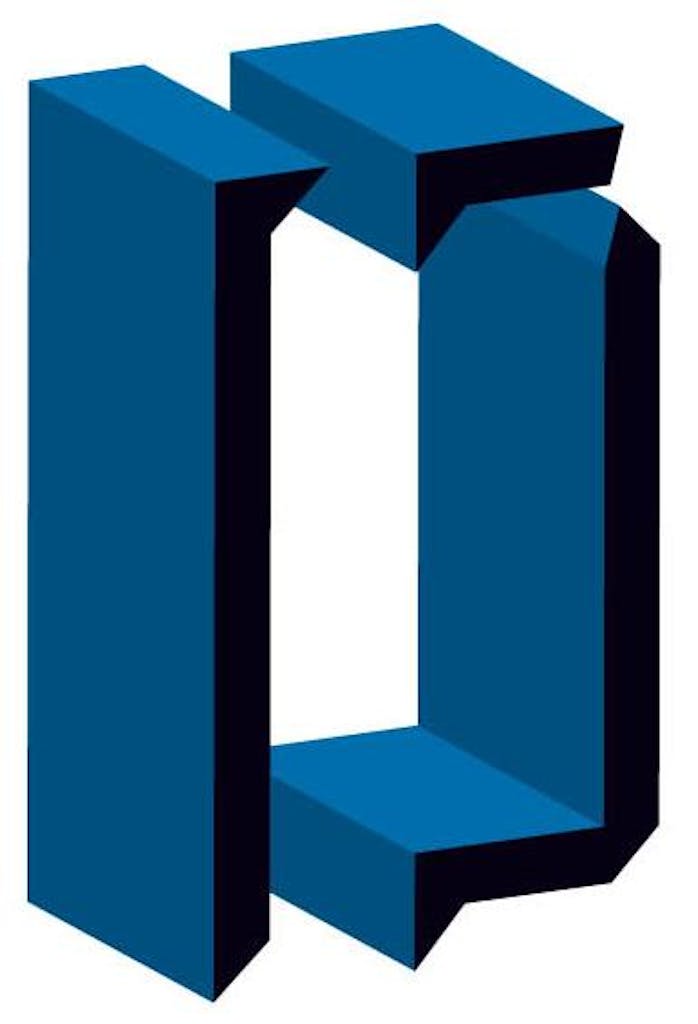What’s not to like about Tony Romo? He’s the most exciting Dallas Cowboys quarterback since Troy Aikman in his prime. He has Don Meredith’s devil-may-care charm, that same winning attitude where all things are possible and, admit it, nothing that happens on a football field is all that important anyway. Born with Roger Staubach’s innate ability to lead and to improvise, he has the talent to transform disaster into triumph, to rally a team and in one magic moment change the course of a game or even a season. An undrafted free agent, Romo has been tested in the NFL for less than two full seasons, but people are already calling him a young Brett Favre. Okay, maybe that’s a stretch. But I’m inclined to agree with the judgment of Brian Urlacher, the Chicago Bears’ All-Pro linebacker, who called Favre “an old Tony Romo.”
So how good is Romo? We’re about to find out. As the Cowboys prepare for a run at the Super Bowl—they lost by a hair in the playoffs last January to the eventual champion New York Giants, a team they’d beaten twice during the regular season—Romo is at the center of everyone’s radar screen. His popularity already exceeds his accomplishments: His number 9 jersey is the league’s hottest seller, in keeping with a franchise that has long led the NFL in TV ratings and brand loyalty. Every aspect of his personal life is the stuff of headlines, especially his relationship with Jessica Simpson. When Staubach was interviewed last spring during a business trip to Raleigh, North Carolina, the reporter diverted from his line of questioning about the economy and asked, “Did Jessica Simpson’s romance with Tony Romo really cost the Cowboys the Super Bowl?” (“It caused debate,” Staubach acknowledged. But the Super Bowl? Come on.)
Romo has emerged as the “Lone Star Joe Namath.” He is as likely to show up in the pages of People magazine or the National Enquirer as Sports Illustrated. Entertainment Tonight sent a reporter to a press conference to ask him about Britney Spears, one of the many bimbos on his speed dial. Anywhere there are cameras and spotlights, you are likely to encounter Romo—judging the Miss Universe pageant, escorting American Idol Carrie Underwood to the Academy of Country Music Awards, throwing out the first pitch at a Cubs-White Sox game in Chicago, playing in a celebrity golf tournament. Even Giants quarterback Eli Manning, who got the best of Romo in the playoffs and is now competing with him as the cover boy for the new season, complained at a press conference last fall that an inordinate number of questions directed at him were about Romo.
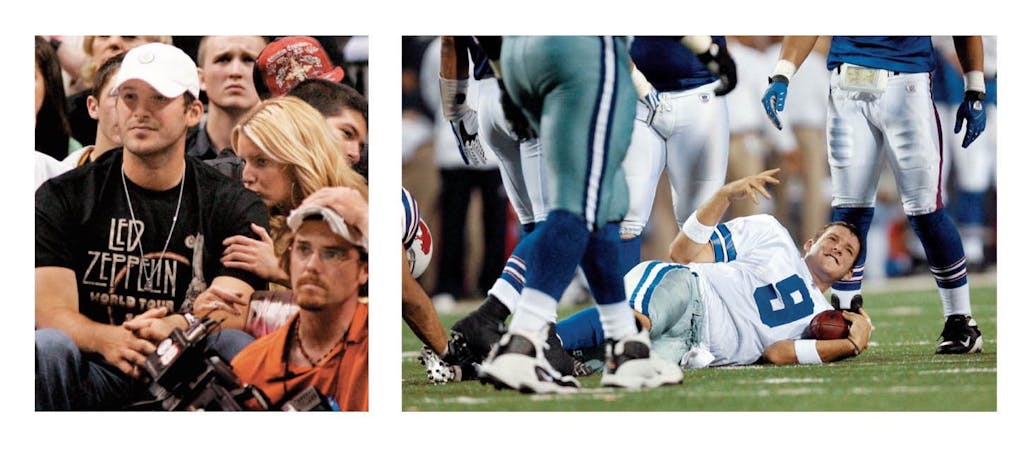
It’s no secret that the quarterback of the Cowboys is a Texas—and a national—icon, better known in the state than the governor or any celebrity. There have been exceptions, of course: Only hard-core fans will recall Steve Pelluer or Gary Hogeboom. But any schoolkid smart enough to recite the heroes of the Alamo can probably also rattle off the Cowboys icons—Meredith, Staubach, and Aikman. Though it is too early to assign Romo a permanent place among the Cowboys elite, he has shown bursts of magic, early indicators that great things are possible.
It’s no secret that the quarterback of the Cowboys is a Texas—and a national—icon, better known in the state than the governor or any celebrity.
One of the most memorable plays in Cowboys history came last season against the St. Louis Rams, when the center snapped the ball over Romo’s head. Resisting the safe move, which would have been falling on the loose ball, Romo instead grabbed it on the bounce, averted two tacklers, and dashed 40 yards for a first down. “Craziest play I’ve ever seen,” All-Pro tight end Jason Witten later told reporters. “I tried to make some blocks out there, but it’s hard because you become a fan. You just sit there and watch him.”
Not since the halcyon days of Aikman and Staubach has a quarterback inspired such confidence among the Cowboys’ rank and file. “His teammates believe in him, and he believes in them,” Staubach told me. “That’s what leadership is.” There was a perfect example last year in Buffalo. Playing before a hostile crowd—Bills fans egged the Cowboys’ bus as the team drove to the stadium—Romo put his team in a hole by fumbling and throwing five interceptions. But in the closing minutes, when things appeared hopeless, he pulled the team together. Completing nine of eleven passes, he directed the Cowboys to a touchdown that cut the Bills’ lead to two points with twenty seconds remaining. Then the Cowboys recovered an onside kick, and Romo moved them close enough for a 53-yard game-winning field goal as time expired. In the dressing room later, he shrugged it off as just another day at the office, telling reporters, “I’m always thinking we’re going to go out and score on the next drive.”
Yet for all the hype, Romo remains an enigma. He has already set passing records for the Cowboys, but he has also failed to produce a victory in a playoff game in each of his two seasons. He has shown that he has the ability to take the team back to the promised land, but he has also embraced the tabloid spotlight in a way that no other Cowboys quarterback ever has. That makes a lot of fans nervous. A friend told me that his mother-in-law loves Romo because he is always smiling. His father-in-law doesn’t trust him because he is always smiling. None of this appears to faze Romo, who treats both triumph and disaster as silly impostors. After botching a hold on what should have been a winning field goal against Seattle in the 2006 playoffs, Romo returned a year later to lead the team to thirteen wins, the Cowboys’ best regular-season record since 1992, when Aikman guided the team to victory in Super Bowl XXVII. Romo put the playoff loss to Seattle in perfect perspective when he said afterward, “I learned a long time ago that if the worst thing that happens to me is sports-related, I’ve lived a pretty good life.”
Romo and Manning will be the most intriguing rivalry in the NFL in the years ahead, not only because the Giants and the Cowboys are the league’s two top franchises and bitter rivals in the tough NFC East but also because of the contrast in their pedigrees. An All-American at Ole Miss, Manning was famous before he was famous, the son of a famous quarterback, the brother of a famous quarterback, the first pick in the 2004 draft. Romo was a nobody from nowhere, a product of renowned football factory Eastern Illinois, ignored in the 2003 draft. The Cowboys signed him for $15,000, pocket change for even journeymen quarterbacks, and then stuck him on the end of the bench for three and a half years. If Quincy Carter hadn’t self-destructed in 2004, Romo probably would have been released before getting a chance to show his stuff.
Romo got the starting job almost by default, replacing the slow-footed Drew Bledsoe in the middle of the 2006 season. And yet in each of his two seasons as a starter, he has been selected to the Pro Bowl. In 2007 he became the first Cowboys quarterback to throw for more than 4,000 yards, and he finished the season with the highest quarterback rating in the NFC. Manning wasn’t especially impressive in the regular season last year, but he was nearly flawless in the playoffs and the Super Bowl.
Why then is Romo getting most of the chatter? Former Giants quarterback Phil Simms has pointed out a wonderful irony: It is easier to keep a low profile in New York than it is in Dallas. “There is so much going on in New York, so many celebrities—I mean, restaurant owners are celebrities—that it’s easier to go unnoticed,” Simms, now the lead NFL analyst for CBS Sports, recently told reporters. “The quarterback for the Dallas Cowboys is probably the most high-profile person in town.”
Fame is and always will be directly correlated to win-loss percentages and an ability to step up in a big game. “There is pressure on any quarterback to win, but if you’re the quarterback of a team with the rich tradition of the Cowboys, the pressure is off the charts,” said Aikman, who led the Cowboys to three of their five Super Bowl titles but who also played on atrocious teams at the beginning and the end of his career. “But if you’re able to win, if you’re successful and add to the legacy, I can’t imagine a greater place to be.”
So Romo’s job description is clear, as are the consequences of failure: God help the poor soul who screws this one up.
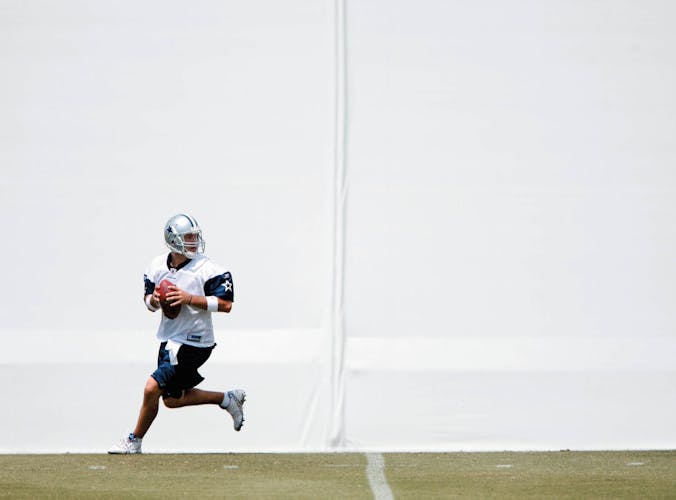
on Meredith retired suddenly at the end of the 1968 season, quitting at the top of his game for reasons that are still difficult to explain but were tragically entwined with the mystique of the Cowboys and the anxieties and adolescent quirks of Dallas’s age of innocence. Four decades later the destinies of the player and the franchise seem willed by the stars. A kid from Mount Vernon, twice an All-American at SMU—Southern Meredith University, some called it—the Cowboys’ first-ever draft choice, the player chosen to lead this franchise to greatness and blamed shamelessly when greatness didn’t come soon enough, Meredith was destiny’s child. “Playing for the Cowboys was something I always wanted to do,” Meredith told me.
Those of us who knew Meredith and are now getting to know Romo are struck by the similarities of the two men—same effervescent, aw-shucks personality; same charismatic leadership style; same athleticism; same gritty toughness. Both excelled in basketball as well as football in high school, and both were natural competitors who loved games, any game at all. A scratch golfer, Romo told my old sportswriter buddy Sam Blair, “I’ve always loved competing, trying to get good at something. It’s just a joy that I get to do [it] for a living.” (Romo declined to be interviewed for this article, a fact I won’t hold against him.) The big difference is that Romo plays on a far superior team than Meredith did, and he has the force of history at his back.
Nobody took a worse beating than Meredith, physically or emotionally. Dandy Don—the nickname was coined by his brother, Billy Jack—played most of his career behind a terrible offensive line, throwing to mainly journeymen receivers (“Bullet” Bob Hayes was a magnificent exception), before a crowd of neophyte fans, with an ignorant gallery of sportswriters who had never seen pro football up close. Confession: I was the most offensive of this sorry lot. When Meredith threw an infamous interception against the Cleveland Browns at the Cotton Bowl in 1965, in a game that decided the conference championship, a game the Cowboys should have won, one that would have allowed them to turn the corner and be recognized as a legitimate contender, I borrowed the Four Horsemen of the Apocalypse lead that Grantland Rice used years before to describe the Notre Dame backfield and twisted it to read: “The Four Horsemen rode again Sunday in the Cotton Bowl. You remember their names: Death, Famine, Pestilence and Meredith.”
I heard later that Meredith thought that line was pretty funny, and at least it was lighthearted. But I wrote some heavy-handed things too, and I’ve regretted them and felt stabs of guilt wondering if I’d helped push him to early retirement. I had enormous respect for the way Meredith played through the pain and suspect Romo has the same brand of courage: Being injured and being hurt are two different things, Romo has said, adding that you can’t play in this league if you can’t play hurt. But like a lot of early-day Cowboys fans, I was impatient for success and quick to assign blame. That’s the downside of being an icon: You’re always the primary target of critics.
The Cowboys learned the brutal lessons of toughness and pain at Meredith’s expense, which must have made the jeers that much sharper. Craig Morton, who was Meredith’s backup from 1965 until he retired, remembered his shock at hearing fans at the Cotton Bowl boo Meredith. “I tried to tell him I was sorry,” Morton told me, “but he said, ‘It’s going to happen to you too. You won’t believe how quick it’s going to happen.’” Morton recalled a game in which Meredith was hauled off the field on a stretcher, his face covered with blood. “He looked up at me and said, ‘You wanted it, Curley. You got it,’” Morton told me. “I’m thinking, ‘No, no, wait . . .’”
When I called Meredith at his home in Santa Fe—he and his wife, Susan, split their time between Santa Fe and Rancho Mirage, California—I wasn’t sure he’d want to talk to me. To my surprise, he came on the line laughing and saying, “If I’d known that all the defense wanted was the ball, I’d have given it to them and saved myself about two million hits to the head.” In a flash, we’d retreated forty-something years, two young wiseasses discussing the price of apples. I told him that a lot of Cowboys fans looked at Romo and saw a young Meredith, which inspired him to quip, “You mean he’s that good-looking?”
Meredith confessed that he doesn’t watch football, but he has seen Romo play. “They must like him if they gave him a $67.5 million contract,” he said. “Or was that a typo?” Meredith remembered that in 1960, before the Cowboys actually came together as a team, he signed a personal-services contract with owner Clint Murchison Jr. worth $150,000 over five years—and that seemed like big money at the time.
“Signing with the Cowboys was so very special in my life,” he told me. “The thing I’m happiest about is that I talked Clint into giving me a five-thousand-dollar advance, which I gave to my parents, Jeff and Hazel, to pay off the wholesalers for their dry goods store on the square in Mount Vernon.”
Meredith, who is now seventy, had a stroke in 2004, which has affected his eyesight, and lack of balance keeps him from playing golf. “I’m feeling so-so,” he said. “I’m still Jeff and Hazel’s baby boy and really happy to be here. Oh, and I dyed my hair gray.” When I asked if he had any regrets or harbored any bad feelings, he began singing Willie Nelson’s “One Day at a Time”: “I live one day at a time/I dream one dream at a time/Yesterday’s dead and tomorrow is blind/And I live one day at a time.”
I told him that a lot of Cowboys fans looked at Romo and saw a young Meredith, which inspired him to quip, “You mean he’s that good-looking?”
Morton, who was the fifth player selected in the 1965 draft, is still surprised that Meredith retired so young. “He was just thirty,” Morton said. “He hadn’t even reached his peak. He could have played another ten years, in which case Roger and I wouldn’t have happened.” Morton and I both knew that a big reason for Meredith’s early retirement was Tom Landry, who never fully appreciated that football should be fun, that a quarterback could have a sense of humor and still love the game. Meredith told me that after the 1968 season, he went into Landry’s office and told the coach that he was thinking about retiring. He believed—desperately hoped—that Landry would say, “Come on, Don, you’re in your prime, and your best years are still ahead.” Instead, Landry replied, “Don, I think you are doing exactly the right thing.” Then he suggested they drop to their knees and pray.
Meredith hung up his jersey eleven years before Romo was born, so you have to wonder if the current Cowboys quarterback has ever heard of him. Sam Blair, who wrote for the Dallas Morning News for 41 years and knew Meredith from his college days, asked Romo that exact question: What did he know about Meredith? The young quarterback was ready, chapter and verse. “He was the guy who really started the franchise,” Romo told Blair. “He put the position of quarterback on the map. He’s the pioneer to Staubach, Aikman, and the guys who came after them. It’s kind of neat to have a club like that: Such great players and it all started with him.”
“Neat.” Now, that’s exactly the kind of word Meredith would have used.
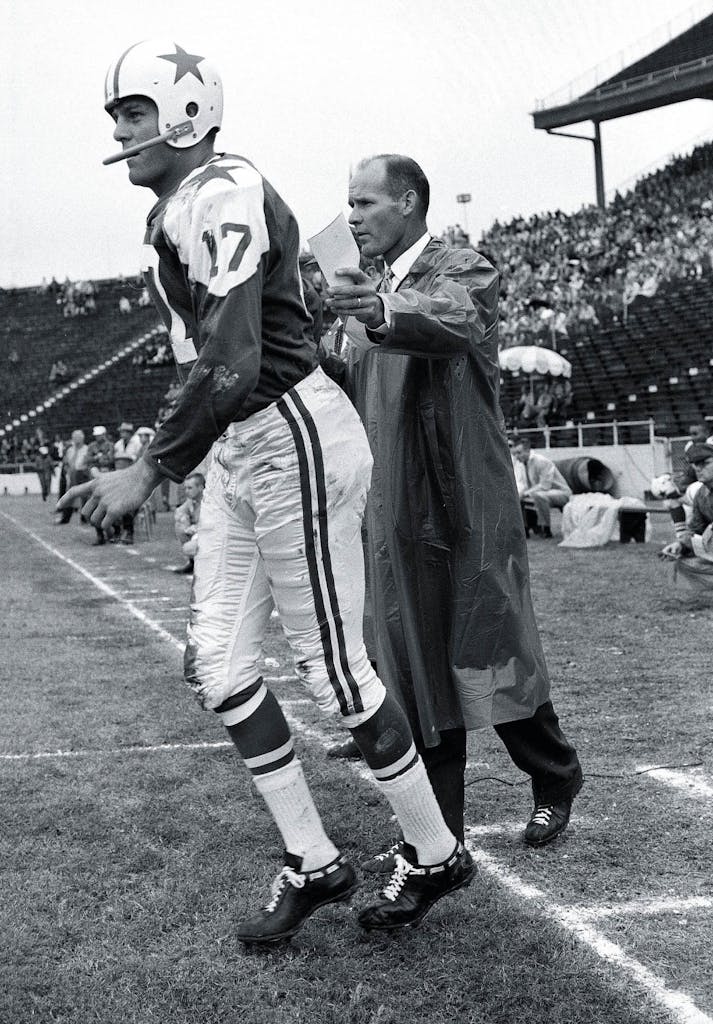
I wonder what Landry would have made of Romo? Landry didn’t like scrambling quarterbacks or anything else unorthodox, unless he had invented it. I’m sure he would have agreed with Bill Parcells’s initial evaluation that Romo would never make it in the NFL because of his sidearm throwing style. David Lee, an assistant under Parcells, told an ESPN.com columnist that Parcells had predicted as much. “With that delivery, he’ll have six out of every seventy passes batted down,” Lee remembered Parcells saying. When Romo heard that, he begged Lee to help him change his motion. Lee had his doubts that Romo would even make the team but nevertheless agreed to give him private lessons at Valley Ranch. Lee rigged a ten-foot-high net that took the place of the defensive line and forced Romo to release the ball at a higher point. After countless practice throws, Romo adjusted to a three-quarter motion. You still see traces of the sidearm, but Romo is so good at moving around and finding throwing lanes outside the pass rush that his delivery has never been a problem.
One thing Landry would have loved is Romo’s dedication to improve. In the weeks before the start of every season, Romo goes back to the basics, examining his throwing motion and checking his footwork, drop-back style, and ability to read coverages. At the Cowboys minicamp in June, he concentrated on standing taller, “calming” his feet before throwing, and trying passes from various angles with different motions. “You practice a lot of different shots in basketball,” he told the Sporting News last spring. “Your fadeaway, your jumper. You practice a lot of different shots in golf. I find it funny that most quarterbacks practice the same throwing motion. . . . In a game your arm is going to be in different slots because you’ve got to throw around people. You want to be able to stand taller and throw down over someone and put a little more touch.” Jason Garrett, the Cowboys’ offensive coordinator and a good bet to be their next head coach, thinks that Romo’s most impressive asset is not necessarily his strong arm, his quick release, or his mobility but rather his discipline and his desire to be a good football player. “He comes in, he’s ready to work,” Garrett told the Sporting News. “He gets dialed in at practice and really focuses.”
Eventually, Landry came to believe that Staubach was the best quarterback to play in the NFL, the greatest combination passer, athlete, and leader. But that evaluation came after years of criticizing what he saw as Staubach’s reckless style. “Coach Landry wasn’t happy with my scrambling,” Staubach recalled. “It caused consternation between us. But I put up with his play-calling, and he put up with my scrambling.” Over the years, Landry adapted to Staubach’s style but never fully accepted it. “I was still running after eleven years,” Staubach told me. “And he was still saying, ‘Roger, you’ve got to learn to . . .’ I was trying to tell him, ‘Coach, don’t you know I’m about to retire?’”
So what does Staubach think of Romo? He calls him the real deal. “I was right about Troy,” Staubach said. “I saw him get beat around as a rookie, but he never complained. Romo’s got the same stuff.” Staubach believes that Cowboys coaches should encourage Romo to trust his gut. “If I saw a third-and-four and thought I could get it by running, I’d take off,” Staubach told me. “It was instinct. Favre does that, and so does Romo. The Cowboys need to let him run. He’ll mature. That’s what Landry did with me. I got smarter, and so will Tony.”
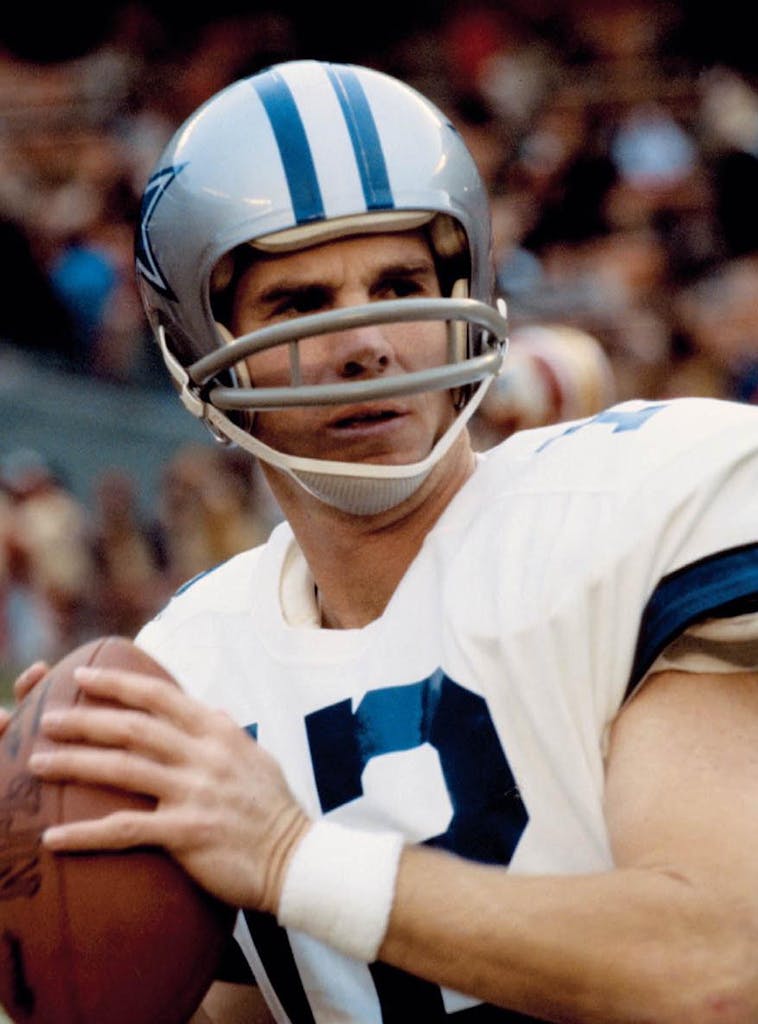
Over the past decade Cowboys fans have watched a procession of forgettable names occupy the quarterback position—Randall Cunningham, Quincy Carter, Ryan Leaf, Chad Hutchinson, Vinny Testaverde, Drew Bledsoe—but for the first twenty years of their existence, the Cowboys usually had an embarrassment of riches at that spot.
Back in 1964, a year before the Cowboys drafted Morton and began grooming him as the quarterback who would replace Meredith, the club drafted Staubach, even though he wouldn’t be available for another five years because of military obligations. (Amazingly, the team got him in the tenth round, having discovered that Staubach played a year at the New Mexico Military Institute before entering the Naval Academy and was thus eligible to be drafted his junior year.) Staubach was a 27-year-old rookie and a Vietnam veteran when he finally joined the Cowboys, in 1969. That was the year Morton took over the starting job. A classic drop-back passer in the mold of the great Giants quarterbacks during Landry’s formative years in the NFL, Morton took the Cowboys to their first Super Bowl, in January 1970, a defensive struggle won by the Baltimore Colts.
Nevertheless, Landry was intrigued by Staubach’s potential and announced before the 1971 season that the job was up for grabs. In a rare moment of indecision, Landry kept changing quarterbacks for nearly half a season, first Staubach, then Morton, then Staubach, then Morton. Landry believed that players were more or less interchangeable and seemed blind to the effect this was having on the team. “In the middle of the season, we were four and two, one game behind the Redskins,” Staubach recalled. “At a team meeting before a game against Chicago, he told us we were going to alternate after every play. Craig and I looked at each other like, ‘What’s this?’” The Cowboys gained a lot of yards but lost to a mediocre Bears team. The following week Landry admitted that having two quarterbacks had been a terrible idea and announced that Staubach was the man for the remainder of the season.
“It was a life-changing moment,” Staubach told me. “We had a good team, but we weren’t clicking, weren’t hitting on all cylinders. Landry’s theory was that we were both good quarterbacks, that whoever he put in charge would do the job. But football is emotion, it’s leadership. If Landry had gone the other way, gone with Craig, I probably would have left the Cowboys.”
With Staubach at the controls, the Cowboys won ten straight games, including Super Bowl VI, Dallas’s first championship. It was the beginning of a glorious stretch in which Staubach and the Cowboys appeared in three more Super Bowls over the next four years, beating the Denver Broncos and losing twice to the Pittsburgh Steelers. Staubach went on to a Hall of Fame career, celebrated for leading his team to 23 fourth-quarter comeback victories, including the original “Hail Mary pass,” which beat the Minnesota Vikings in the playoffs in 1975.
Morton had his own life-changing moment in 1972, as he reminded me in a telephone conversation from his home in Berkeley, where he works in development and fund-raising for his alma mater, the University of California. After Staubach separated his shoulder in the opening game, Morton led the Cowboys to a divisional playoff against the San Francisco 49ers. Then destiny reared its savage head. With the Cowboys offense sputtering and only ninety seconds remaining, Landry sent Staubach into the game, even though he hadn’t played for months. Staubach responded by throwing two touchdown passes and leading the team to victory.
Even so, Morton assumed that he would start the NFC championship game the following week, against the Washington Redskins. “I’d played the entire season, while Staubach had played less than two minutes,” Morton recalled. But again, Landry appeared indecisive. “Landry called Roger and me into his office,” Morton continued. “I remember coming in with all these reels of film under my arm and Landry saying—and these were his exact words—‘Craig, you had an unbelievable year. We wouldn’t be in the championship game without you. Roger, you’re a great quarterback, and you’re going to start against the Redskins.’ I was so stunned that I dropped my reels of film.” Though the Redskins dominated the championship game, beating the Cowboys 26-3, Morton didn’t play a down. “I knew then I couldn’t play in Dallas anymore,” he said. The Cowboys traded Morton to the Giants for a number one draft choice, which they used to secure future Hall of Fame defensive tackle Randy White. Morton was later traded to the Broncos, where he was beaten in Super Bowl XII by—wouldn’t you know it?—his old rival, Staubach.
The “America’s Team” label took hold during Staubach’s reign, in large part because of Staubach’s squeaky-clean, all-American image: Heisman Trophy winner, graduate of the Naval Academy, devoted family man, as good and trustworthy and square as the state of Ohio, where he grew up. Staubach and his wife, Marianne, met in the fourth grade in Cincinnati. “I met my Jessica Simpson in elementary school,” he joked one day at lunch, Marianne at his side.
Landry hated all that America’s Team stuff, believing correctly that it infuriated opposing teams and put undue pressure on the Cowboys. But it outlived him, and it is likely to outlive its detractors too, as New York Times sports columnist George Vecsey discovered not long ago. When Vecsey wrote that he couldn’t understand why people thought the Cowboys were America’s Team, he was bombarded with nasty e-mails, declaring that if he didn’t love the Cowboys, he didn’t love America—and should get the hell out of the country.
Chatter about America’s Team lessened after Staubach retired and Danny White took over. Not to damn Romo with faint praise, but in some ways he reminds me of White, the unknown soldier among iconic Cowboys quarterbacks. After a brief stint in the World Football League, White was signed in 1976 as a punter and backup to Staubach. He sat on the bench for four years, then got the starting job after a series of concussions convinced Staubach that it was time to quit. White led the Cowboys to three consecutive NFC championship games, from 1980 to 1982, and broke or tied eight Cowboys single-season passing records. Two of the records that Romo broke last year—his 36 touchdown passes and his 4,211 passing yards—had been held by White. Unfortunately, White is remembered as the quarterback who never got Dallas to a Super Bowl, whether it was his fault or not.
White left the Cowboys in 1989, the same year that a blond-haired kid from Henryetta, Oklahoma, rolled into town. Troy Aikman’s heroics revived the sagging fortunes of the Cowboys, but not without some measure of adversity. Though Aikman was clearly the best player in the 1989 draft, no less an expert than Jimmy Johnson, the coach that owner Jerry Jones hired to replace Landry, had grave doubts. In the book Boys Will Be Boys: The Glory Days and Party Nights of the Dallas Cowboys Dynasty, which will be published this month, Jeff Pearlman reveals that Johnson thought Aikman was stiff and mechanical and maybe not smart enough or passionate enough to play in the NFL. In a move that still mystifies, Johnson used a second first-round draft choice to select another quarterback, Steve Walsh, who had won a national title for him at the University of Miami. Though it was clear to everyone except Johnson that Aikman was far superior to Walsh, Johnson gave Aikman the cold shoulder during long stretches of that first season. So much for Jimmy the Genius.
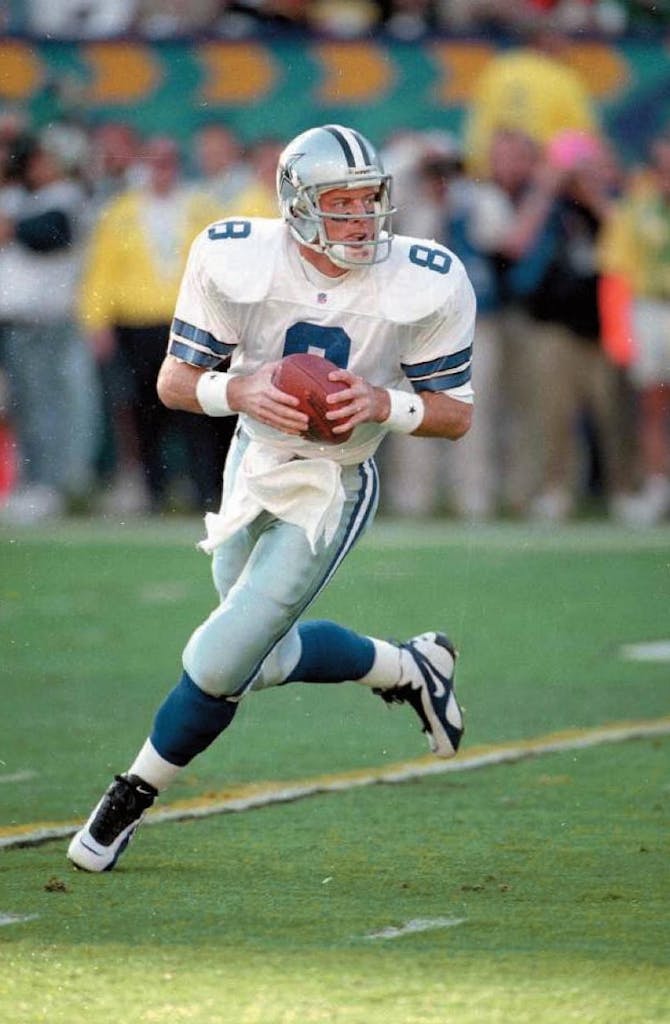
Of course, Aikman was mechanical: Improvising was not his style. He needed receivers to run precise routes, timed to the split second, and when things broke down, he struggled. But Aikman was also a natural—great poise, strength, accuracy—and he had enough speed and agility, at least early in his career, to turn a busted play into positive yardage. What made Aikman a truly great quarterback, however, was his indomitable competitive spirit, his will to win. No matter how many interceptions he threw or how bleak things looked, Aikman never got rattled. Romo shows that same unconquerable desire. “A player like Romo or like Favre will make bad plays by forcing throws, but they have both made far more great plays with that style,” Aikman told me. “You can’t have one without the other—even though a lot of coaches think you can.”
In 1997 Aikman became the first Cowboys quarterback to have three straight 3,000-yard seasons, but because of the salary cap—and mismanagement by Jones, who in a span of five years fired not only Johnson but also his replacement, Barry Switzer—the team had started its long decline. Aikman dealt with a string of bad coaches, and he took more than his fair share of punishment on the field. In 2000 Redskins linebacker LaVar Arrington hit Aikman with such force that his head literally bounced off the turf, leaving a dent in his helmet. It was Aikman’s tenth concussion, and it ended his career. Still, Aikman put up some amazing numbers, passing for 32,942 yards. His ninety wins in the nineties is the most by any quarterback in any decade, and his three Super Bowl victories is better than Staubach’s record.
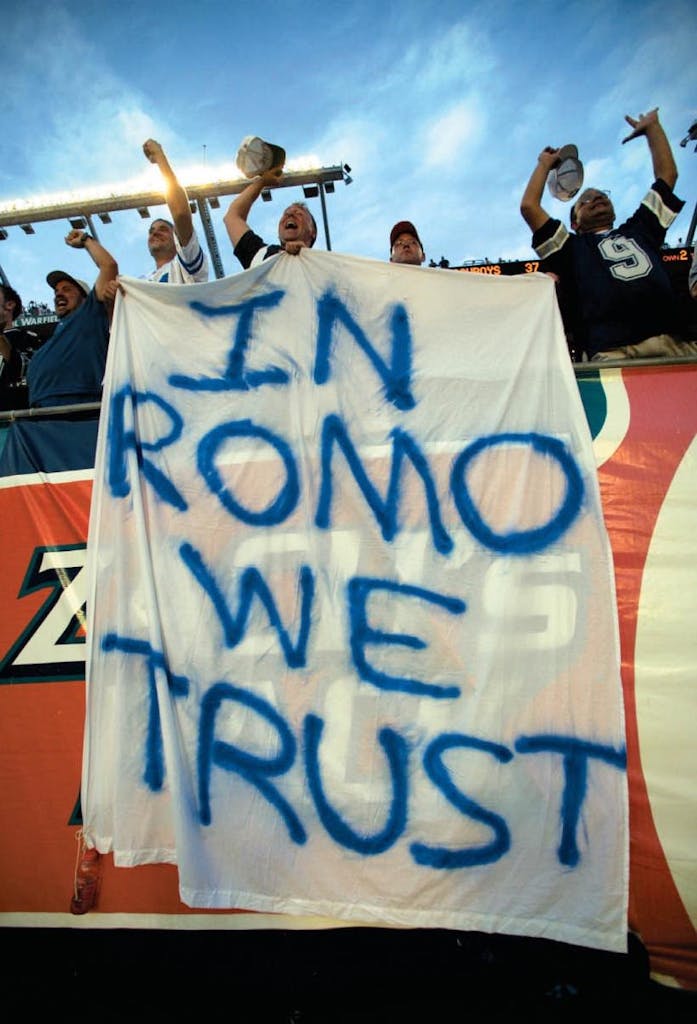
Predictably, today’s Cowboys fans are as silly and impatient as their parents and grandparents were back in Meredith’s day. Witness the shrieks of distress over the Jessica Simpson affair, particularly that little trip to Mexico last January, a week before the playoff game against the Giants. Agreed, it may be fair to ask why her? Romo could have his pick of blondes with prominent balconies. One blogger labeled it “the Affleck/J-Lo Corollary.” Two young celebrities meet, find each other attractive, and start thinking, “Oh, my God, I can’t believe I’m sleeping with [fill in the name here].” But Romo offered a perfectly reasonable explanation for the Mexican vacation. Which was the better choice, he inquired, slipping off for a few quiet days in Mexico or going to Las Vegas and getting drunk? This is precisely the sort of straight talk that has attracted Romo a burgeoning crowd of admirers.
Foremost among them, incidentally, are Dallas’s two Hall of Fame quarterbacks, Staubach and Aikman, and a third quarterback who is sure to join them in the Hall in five or six years, Favre. All agree that Romo has the physical tools to succeed, but more than that he has the golden intangibles that separate the good quarterbacks from the great ones—a knack for the big play and a feel for the game.
“When I see him play, it reminds me of myself,” Favre told the Milwaukee Journal Sentinel last season before a showdown between the Cowboys and the Packers, which Dallas won 37-27 behind Romo’s four touchdown passes. “His creativity to bail himself out is very good. And without being in his head, he probably has the same mentality I had in that there’s never a bad play, which can get you in trouble, but for the most part it has worked for me.”
“Tony’s a terrific player,” Aikman said. “He’s been brilliant, and he has the ability to create something when there’s not a play or when guys are covered.”
“He’s a tremendous competitor,” Staubach said. “You can just see those juices flowing.”
Romo has the chance to take his place among the icons of the Cowboys dynasty, but the clock is already ticking. All the old quarterbacks sounded the same note of caution: A quarterback is only as good as his supporting cast, and supporting casts have a limited shelf life. In other words, the time is now. Romo is only 28 years old, but some of his key teammates, in particular Terrell Owens, his best receiver, are in their mid-thirties. It’s now or never for this team—and maybe for Romo too. “In today’s game you’ve got to take advantage of the opportunity when it’s there,” Aikman told me. “When history is written, nobody will remember the stats. They’ll remember how you did in January.”
- More About:
- Sports
- NFL
- Longreads
- Football
- Cowboys
- Troy Aikman
- Tony Romo
- Tom Landry
- Dallas


